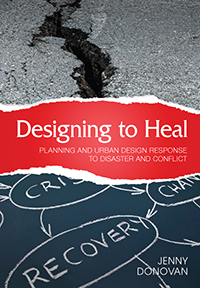
Published by CSIRO Publishing
Author: Jenny Donovan
ISBN: 9780643106475
Joni Mitchell once sang, ‘you don’t know what you’ve got ‘til it’s gone’. This is so true in disaster-affected communities. Our mental maps and the things we take for granted are redrawn. However, early in the recovery process, the relationship between people and their natural and built environment can be minimised in favour of meeting basic needs and replacing what is lost.
The push is often to get things rebuilt as quickly as possible, partly because decision-makers think this is what’s needed, and partly it’s political and not wanting to be ‘too slow’. In early recovery meetings, project managers may do the sums in their head, ‘x number of houses lost multiplied by 4-6 months building time, divided by the number of builders, equals recovery will be over by September’. The reality is much messier and few people are ready to make those decisions, often within the first year.
This is why Jenny Donovan’s Designing to Heal is an important resource. It focuses on the planning and urban design questions faced by communities, planners, builders, financiers, public servants and emergency managers. It is the sort of book I would have liked to refer to when I was working with the Strathewen community in Victoria during their memorial process.
Using diverse case studies, Designing to Heal focuses on how planners and urban designers can assist people affected by disasters through the recovery journey and, in the process, become more resilient for future disruptions. These case studies range from conflict zones such as Northern Ireland and Ethiopia to the disaster-affected areas of Kinglake Ranges and Marysville as well as Sri Lanka. Each case study is unique in nature and through careful description, Donovan highlights quite striking examples of good and bad practice:
- Delicately balancing competing demands of remembrance, urban facility, commercial viability and security in designing the World Trade Center memorial; a highly charged and high-profile incident, where everyone feels ownership.
- How to balance the old and the new when moving a nation’s capital in a small country after the volcanic eruption on Monserrat in 1995. This highlights the need to involve the private sector and create a link to the old capital while developing something that is forward-thinking.
- Re-imaging communities in conflict areas in Belfast by using the cultural importance of murals to move a dialogue of violence and conflict to peace and strength.
Donovan tackles the notion of build-it-back-better, which rolls off our tongues as a given, but she recognises that it is a balancing act; respecting the familiar, valued character and identity of a place, with addressing the problems of place. Often it is regarded as an either/or.
The book examines the oft-forgotten relationship that people have with the built and natural environment and what that means when things changes. In doing so, book places people at the centre of these issues. This may not seem revolutionary but with an increasing practice of using the military and large-scale project management firms during recovery management rather than community-led approaches, process can take priority over people.
The book is well structured and eminently readable with liberal use of images to hold the interest of readers. Donovan frames the case studies by drawing on the recovery literature and interviews with design practitioners and others to understand the context in which the projects were undertaken. She presents recovery in its non-linear messiness, which is helpful to inform otherwise linear management processes. She is also humble enough to recognise that she herself is not always right, such as the foreshore project in Hambantota, Sri Lanka. The books closing chapters identity elements of good practice in designing to heal and then ultimately what the outcomes are that should be sought (i.e. the characteristics of place that are designed to heal).
In Hobfall’s Principles of Psychosocial Support, hope is one of the key pillars to helping people recover from trauma. Being able to listen, understand and reflect the diverse needs of a community, in a physical form, without creating unrealistic expectations, is the facilitator of hope. For urban planners, ministerial advisers and philanthropists, this is a book that should be reached for before uttering the words ‘we will rebuild’.


